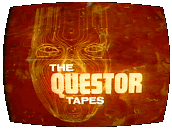 Following the mysterious disappearance of its creator, Nobel-prize-winning physicist Dr. Emil Voslovik, work continues in his absence to complete his final creation: a sentient android. A team of university researchers with corporate and international sponsors attempts to complete construction of the Questor android, but decide not to use the programming prepared by Voslovik. Voslovik’s assistant, engineer Jerry Robinson, protests the sudden swap of programs, but it turns out that his fears are unfounded: Questor does not activate after receiving the substitute program. Even when the correct program is loaded, Questor shows no signs of life. The team constructing Questor adjourns, with team leader Darrow suggesting that the android should be dismantled, as the advanced technology developed by Voslovik still has some value. Unknown to the scientists, Questor gains consciousness later that night, using specialized tools to mold his plastic appearance into a much more human form, but his speech and mannerisms remain robotic. As part of his programming, he immediately seeks out Jerry Robinson to ask for help in finding Dr. Voslovik.
Following the mysterious disappearance of its creator, Nobel-prize-winning physicist Dr. Emil Voslovik, work continues in his absence to complete his final creation: a sentient android. A team of university researchers with corporate and international sponsors attempts to complete construction of the Questor android, but decide not to use the programming prepared by Voslovik. Voslovik’s assistant, engineer Jerry Robinson, protests the sudden swap of programs, but it turns out that his fears are unfounded: Questor does not activate after receiving the substitute program. Even when the correct program is loaded, Questor shows no signs of life. The team constructing Questor adjourns, with team leader Darrow suggesting that the android should be dismantled, as the advanced technology developed by Voslovik still has some value. Unknown to the scientists, Questor gains consciousness later that night, using specialized tools to mold his plastic appearance into a much more human form, but his speech and mannerisms remain robotic. As part of his programming, he immediately seeks out Jerry Robinson to ask for help in finding Dr. Voslovik.
Initially skeptical of Questor’s identity and his purpose, Robinson reluctantly gives in to the android’s demand to travel to London to search for Voslovik, finding out along the way that Questor has enormous strength and agility, but no capacity for emotion, and a near-total reliance on Robinson for moral guidance. Darrow, having grown suspicious of Robinson even before Questor’s surprise awakening, instigates an international manhunt for Questor and Robinson, and the two have to lie low in London. Their search leads them to the estate of Lady Helena Trimble, a woman with far-reaching connections but, seemingly, no political ambitions. In a secret chamber on her estate, Voslovik has constructed (and, apparently, abandoned) a surveillance center capable of peeking in on governments, individuals, and nations, with an interface specifically designed for Questor. Unnerved by the implications of this, Robinson loses his nerve and tips off Darrow to Questor’s location.
Questor reveals that he is designed to self-destruct within three days, via a catastrophic overload of his internal nuclear furnace, unless he locates Dr. Voslovik, and Robinson warns Darrow of the impending disaster. Having expressed a fascination with boats for the entire duration his search, despite repeated assurances that Voslovik wasn’t fond of going near water, Questor suddenly pieces the clues together and demands passage to Turkey, where he and Robinson climb to find a vast, hidden chamber within Mt. Ararat, trailed by Darrow the entire time. Questor finally locates Dr. Voslovik, moments away from death, and learns of his origins, a secret directly tied to the future of the human race.
teleplay by Gene Roddenberry and Gene L. Coon
story by Gene Roddenberry
directed by Richard A. Colla
music by Gil Melle
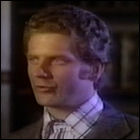 Cast: Robert Foxworth (Questor), Mike Farrell (Jerry Robinson), John Vernon (Dr. Darrow), Lew Ayres (Dr. Voslovik), James Shigeta (Dr. Chen), Robert Douglas (Dr. Michaels), Dana Wynter (Lady Helena Trimble), Majel Barrett (Dr. Bradley), Ellen Weston (Allison Sample), Reuben Singer (Dr. Gorlov), Fred Sadoff (Dr. Audret), Gerald Saunderson Peters (Randolph), Walter Koenig (Administration Assistant), Eyde Girard (Stewardess), Alan Caillou (Immigration Official), Lal Baum (Colonel Hendricks), Patti Cubbison (Secretary)
Cast: Robert Foxworth (Questor), Mike Farrell (Jerry Robinson), John Vernon (Dr. Darrow), Lew Ayres (Dr. Voslovik), James Shigeta (Dr. Chen), Robert Douglas (Dr. Michaels), Dana Wynter (Lady Helena Trimble), Majel Barrett (Dr. Bradley), Ellen Weston (Allison Sample), Reuben Singer (Dr. Gorlov), Fred Sadoff (Dr. Audret), Gerald Saunderson Peters (Randolph), Walter Koenig (Administration Assistant), Eyde Girard (Stewardess), Alan Caillou (Immigration Official), Lal Baum (Colonel Hendricks), Patti Cubbison (Secretary)
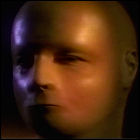 Notes: Co-writer Gene L. Coon was one of the driving creative forces behind the original Star Trek, responsible for such episodes as Arena, Space Seed, The Devil In The Dark, Errand Of Mercy, and Metamorphosis; under the pseudonym Lee Cronin, he also contributed later scripts such as Spock’s Brain. He is often credited as the creator of the Klingons and the contributor of such concepts as the Prime Directive. He died of cancer in 1973, several months before the premiere of The Questor Tapes. Walter Koenig gets a blink-and-you’ll-miss-it walk-on as the assistant who gives Jerry Robinson’s credentials to Darrow – it’s easy to miss him behind the giant ’70s sideburns and moustache.
Notes: Co-writer Gene L. Coon was one of the driving creative forces behind the original Star Trek, responsible for such episodes as Arena, Space Seed, The Devil In The Dark, Errand Of Mercy, and Metamorphosis; under the pseudonym Lee Cronin, he also contributed later scripts such as Spock’s Brain. He is often credited as the creator of the Klingons and the contributor of such concepts as the Prime Directive. He died of cancer in 1973, several months before the premiere of The Questor Tapes. Walter Koenig gets a blink-and-you’ll-miss-it walk-on as the assistant who gives Jerry Robinson’s credentials to Darrow – it’s easy to miss him behind the giant ’70s sideburns and moustache.
LogBook entry by Earl Green
 An Apollo spacecraft is launched – despite the attempted interference of a saboteur – with three astronauts and the initial modules of a massive new space station aboard. President Durant of the United States asks American citizens to vote on the founding of a new “nation in space” using this space station as its capitol, and the vote is overwhelmingly in favor of creating a new spacefaring country: Earth II. The station grows in both size and population, setting out to be a completely democratic society in which any citizen can bring an issue up for a vote. But the first real test of Earth II’s leadership arrives in the form of a Chinese orbital nuclear warhead. A team of astronauts from the station sets out to destroy it, but instead the warhead is left intact without the ability to receive commands from Earth. The ramifications of this event reveals a hawkish faction aboard Earth II, insisting that the weapon be kept for the station’s protection. An opposing faction wants the weapon destroyed completely, fearing it represents too much power for anyone to use ethically. And one person, ignoring the democratic process, takes it upon herself to take the action she fears no one else will take, with disastrous consequences.
An Apollo spacecraft is launched – despite the attempted interference of a saboteur – with three astronauts and the initial modules of a massive new space station aboard. President Durant of the United States asks American citizens to vote on the founding of a new “nation in space” using this space station as its capitol, and the vote is overwhelmingly in favor of creating a new spacefaring country: Earth II. The station grows in both size and population, setting out to be a completely democratic society in which any citizen can bring an issue up for a vote. But the first real test of Earth II’s leadership arrives in the form of a Chinese orbital nuclear warhead. A team of astronauts from the station sets out to destroy it, but instead the warhead is left intact without the ability to receive commands from Earth. The ramifications of this event reveals a hawkish faction aboard Earth II, insisting that the weapon be kept for the station’s protection. An opposing faction wants the weapon destroyed completely, fearing it represents too much power for anyone to use ethically. And one person, ignoring the democratic process, takes it upon herself to take the action she fears no one else will take, with disastrous consequences.written by William Read Woodfield & Allan Balter
(Frank Karger), Mariette Hartley (Lisa Karger), Gary Merrill (Walter Dietrich), Inga Swenson (Ilyana Kovalefskii), Edward Bell (Anton Kovalefskii), Lew Ayres (President Charles Carter Durant), Brian Dewey (Matt Karger), Diana Webster (Hannah Young), Bart Burns (Stiner), John Carter (Hazlitt), Herbert Nelson (Chairman), Serge Tschernisch (Russian), Vince Cannon (Technician), David Sachs (Surgeon), Bob Hoy (West)

 An abandoned pre-war building is taken over by Ryan Electronics to serve as the skunkworks for a crash program to find and develop the electronic recording medium that will supplant magnetic tape. With its wartime history as a command post for visiting American soldiers, and an even longer history as a haunted house stretching back into the late 1800s, the building isn’t anyone’s favorite place. Some members of the electronics R&D team refuse to work there, and a visit to the pub reveals that the locals believe that any new secret project there is military (and hazardous) in nature. The sole female member of the Ryan Electronics team, Jill, experiences a vision in a supply room formerly used by the U.S. Army, catching a fleeting glimpse of a screaming woman, and project director Peter isn’t convinced until he hears the screaming for himself. Determined to debunk the hauntings so his team can get down to their real work, Peter decides to throw the team’s resources at the problem, using every kind of sensing and recording equipment at their disposal and regarding the sightings as merely misinterpreted data. Even though sightings continue, none of the group’s equipment manages to record any of it. After several further sightings, Peter becomes convinced that the sightings are a message recorded in the very stones of the building itself, a “stone tape” recorded by a massive output of psychic energy, though the haunting nature of the repeated sightings gives his team the uncomfortable feeling that the burst of energy was provided by the moment of the screaming woman’s death. Gradually becoming unhinged by an obsessive belief that the “stone tape” represents exactly the kind of breakthrough recording medium his team was sent to discover, Peter begins probing the room with UV light, lasers, and blasts of high-frequency sound, and eventually the sightings stop: his team believed he’s “wiped the tape.”
An abandoned pre-war building is taken over by Ryan Electronics to serve as the skunkworks for a crash program to find and develop the electronic recording medium that will supplant magnetic tape. With its wartime history as a command post for visiting American soldiers, and an even longer history as a haunted house stretching back into the late 1800s, the building isn’t anyone’s favorite place. Some members of the electronics R&D team refuse to work there, and a visit to the pub reveals that the locals believe that any new secret project there is military (and hazardous) in nature. The sole female member of the Ryan Electronics team, Jill, experiences a vision in a supply room formerly used by the U.S. Army, catching a fleeting glimpse of a screaming woman, and project director Peter isn’t convinced until he hears the screaming for himself. Determined to debunk the hauntings so his team can get down to their real work, Peter decides to throw the team’s resources at the problem, using every kind of sensing and recording equipment at their disposal and regarding the sightings as merely misinterpreted data. Even though sightings continue, none of the group’s equipment manages to record any of it. After several further sightings, Peter becomes convinced that the sightings are a message recorded in the very stones of the building itself, a “stone tape” recorded by a massive output of psychic energy, though the haunting nature of the repeated sightings gives his team the uncomfortable feeling that the burst of energy was provided by the moment of the screaming woman’s death. Gradually becoming unhinged by an obsessive belief that the “stone tape” represents exactly the kind of breakthrough recording medium his team was sent to discover, Peter begins probing the room with UV light, lasers, and blasts of high-frequency sound, and eventually the sightings stop: his team believed he’s “wiped the tape.”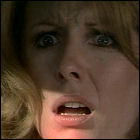 Tom Chadbon (Hargrave), John Forgeham (Maudsley), Philip Trewinnard (Stewart), James Cosmo (Dow), Neil Wilson (Sergeant), Christopher Banks (Vicar), Michael Graham Cox (Alan), Hilda Fenemore (Bar Helper), Peggy Marshall (Bar Lady)
Tom Chadbon (Hargrave), John Forgeham (Maudsley), Philip Trewinnard (Stewart), James Cosmo (Dow), Neil Wilson (Sergeant), Christopher Banks (Vicar), Michael Graham Cox (Alan), Hilda Fenemore (Bar Helper), Peggy Marshall (Bar Lady)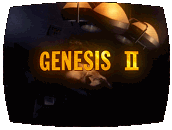
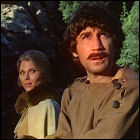 Cast: Alex Cord (Dylan Hunt), Mariette Hartley (Lyra-a), Ted Cassidy (Isiah), Percy Rodrigues (Primus Kimbridge), Harvey Jason (Singh), Titos Vandis (Primus Yuloff), Bill Striglos (Kellum), Lynne Marta (Primus Harper-Smythe), Harry Raybold (Slan-n), Majel Barrett (Primus Dominic), Leon Askin (Overseer), Liam Dunn (Janos), Scott Graham (Tyranian Teacher), Ed Ashley (Wehr-r), Linda Grant (Astrid), Robert Swan (Lahyn-n), Beulah Quo (Primus Lu Chan), Dennis Robertson (General), Ray Young (Tyranian Teacher #2), Tom Pace (Brian), Teryl Willis (Cardiologist), David Westburg (Station Operator), Robert Hathaway (Shuttle Car Operator), Tammi Bula (Teenager)
Cast: Alex Cord (Dylan Hunt), Mariette Hartley (Lyra-a), Ted Cassidy (Isiah), Percy Rodrigues (Primus Kimbridge), Harvey Jason (Singh), Titos Vandis (Primus Yuloff), Bill Striglos (Kellum), Lynne Marta (Primus Harper-Smythe), Harry Raybold (Slan-n), Majel Barrett (Primus Dominic), Leon Askin (Overseer), Liam Dunn (Janos), Scott Graham (Tyranian Teacher), Ed Ashley (Wehr-r), Linda Grant (Astrid), Robert Swan (Lahyn-n), Beulah Quo (Primus Lu Chan), Dennis Robertson (General), Ray Young (Tyranian Teacher #2), Tom Pace (Brian), Teryl Willis (Cardiologist), David Westburg (Station Operator), Robert Hathaway (Shuttle Car Operator), Tammi Bula (Teenager)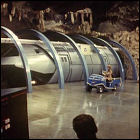 Notes: If Gene Roddenberry liked working with you that one time, Gene Roddenberry will hire you again. Cases in point: Ted Cassidy played Ruk in the
Notes: If Gene Roddenberry liked working with you that one time, Gene Roddenberry will hire you again. Cases in point: Ted Cassidy played Ruk in the 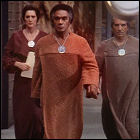 artists. Dylan Hunt would be recast in his next TV adventure (1974’s Planet Earth), and would be renamed (but not recast) for one last try-out in the 20th century, 1975’s Strange New World; Roddenberry’s Dylan Hunt/PAX concept wouldn’t be revisited further until a space-based revamp transformed it into the 21st century syndicated series Gene Roddenberry’s Andromeda, for which all of the earlier attempts nearly 30 years earlier can be regarded misfired pilots.
artists. Dylan Hunt would be recast in his next TV adventure (1974’s Planet Earth), and would be renamed (but not recast) for one last try-out in the 20th century, 1975’s Strange New World; Roddenberry’s Dylan Hunt/PAX concept wouldn’t be revisited further until a space-based revamp transformed it into the 21st century syndicated series Gene Roddenberry’s Andromeda, for which all of the earlier attempts nearly 30 years earlier can be regarded misfired pilots.
 Cast: Robert Foxworth (Questor), Mike Farrell (Jerry Robinson), John Vernon (Dr. Darrow), Lew Ayres (Dr. Voslovik), James Shigeta (Dr. Chen), Robert Douglas (Dr. Michaels), Dana Wynter (Lady Helena Trimble), Majel Barrett (Dr. Bradley), Ellen Weston (Allison Sample), Reuben Singer (Dr. Gorlov), Fred Sadoff (Dr. Audret), Gerald Saunderson Peters (Randolph), Walter Koenig (Administration Assistant), Eyde Girard (Stewardess), Alan Caillou (Immigration Official), Lal Baum (Colonel Hendricks), Patti Cubbison (Secretary)
Cast: Robert Foxworth (Questor), Mike Farrell (Jerry Robinson), John Vernon (Dr. Darrow), Lew Ayres (Dr. Voslovik), James Shigeta (Dr. Chen), Robert Douglas (Dr. Michaels), Dana Wynter (Lady Helena Trimble), Majel Barrett (Dr. Bradley), Ellen Weston (Allison Sample), Reuben Singer (Dr. Gorlov), Fred Sadoff (Dr. Audret), Gerald Saunderson Peters (Randolph), Walter Koenig (Administration Assistant), Eyde Girard (Stewardess), Alan Caillou (Immigration Official), Lal Baum (Colonel Hendricks), Patti Cubbison (Secretary) Notes: Co-writer Gene L. Coon was one of the driving creative forces behind the original Star Trek, responsible for such episodes as Arena, Space Seed, The Devil In The Dark, Errand Of Mercy, and Metamorphosis; under the pseudonym Lee Cronin, he also contributed later scripts such as Spock’s Brain. He is often credited as the creator of the Klingons and the contributor of such concepts as the Prime Directive. He died of cancer in 1973, several months before the premiere of The Questor Tapes. Walter Koenig gets a blink-and-you’ll-miss-it walk-on as the assistant who gives Jerry Robinson’s credentials to Darrow – it’s easy to miss him behind the giant ’70s sideburns and moustache.
Notes: Co-writer Gene L. Coon was one of the driving creative forces behind the original Star Trek, responsible for such episodes as Arena, Space Seed, The Devil In The Dark, Errand Of Mercy, and Metamorphosis; under the pseudonym Lee Cronin, he also contributed later scripts such as Spock’s Brain. He is often credited as the creator of the Klingons and the contributor of such concepts as the Prime Directive. He died of cancer in 1973, several months before the premiere of The Questor Tapes. Walter Koenig gets a blink-and-you’ll-miss-it walk-on as the assistant who gives Jerry Robinson’s credentials to Darrow – it’s easy to miss him behind the giant ’70s sideburns and moustache.
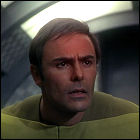 Cast: John Saxon (Dylan Hunt), Janet Margolin (Harper-Smythe), Ted Cassidy (Isiah), Christopher Cary (Baylok), Diana Muldaur (Marg), Sally Kemp (Treece), Johana de Winter (Villar), Claire Brennen (Delba), Corrine Camacho (Bronta), Majel Barrett (Yuloff), Jim Antonio (Jonathan Connor), Aron Kincaid (Gorda), John Quade (Kreeg Commandant), Rai Tasco (Pater Kimbridge), Sara Chattin (Thetis), Lew Brown (Merlo), Raymond Sutton (Kreeg Captain), Joan Crosby (Kyla), James Bacon (Partha), Craig Hundley (Harpsichordist), Robert McAndrew (First Dink), Bob Golden (Second Dink), Susan Page (Little Girl)
Cast: John Saxon (Dylan Hunt), Janet Margolin (Harper-Smythe), Ted Cassidy (Isiah), Christopher Cary (Baylok), Diana Muldaur (Marg), Sally Kemp (Treece), Johana de Winter (Villar), Claire Brennen (Delba), Corrine Camacho (Bronta), Majel Barrett (Yuloff), Jim Antonio (Jonathan Connor), Aron Kincaid (Gorda), John Quade (Kreeg Commandant), Rai Tasco (Pater Kimbridge), Sara Chattin (Thetis), Lew Brown (Merlo), Raymond Sutton (Kreeg Captain), Joan Crosby (Kyla), James Bacon (Partha), Craig Hundley (Harpsichordist), Robert McAndrew (First Dink), Bob Golden (Second Dink), Susan Page (Little Girl)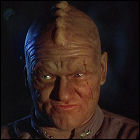 Notes: Planet Earth is based on a story idea that Gene Roddenberry had mooted as a “possible future episode” of both the original
Notes: Planet Earth is based on a story idea that Gene Roddenberry had mooted as a “possible future episode” of both the original 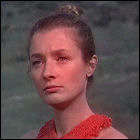 producer Robert Justman, is credited as the producer of Planet Earth as well. Diana Muldaur had appeared in the original Star Trek episodes
producer Robert Justman, is credited as the producer of Planet Earth as well. Diana Muldaur had appeared in the original Star Trek episodes 
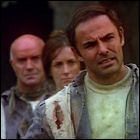 Cast: John Saxon (Captain Anthony Vico), Catherine Bach (Guide), Norland Benson (Hide), Martine Beswick (Tana), Reb Brown (Sprang), Keene Curtis (Doctor Scott), Dick Farnsworth (Elder), Gerrit Graham (Daniel), Bill McKinney (Badger), Kathleen Miller (Allison Crowley), James Olson (Surgeon), Ford Rainey (Cyrus), Cynthia Wood (Arana)
Cast: John Saxon (Captain Anthony Vico), Catherine Bach (Guide), Norland Benson (Hide), Martine Beswick (Tana), Reb Brown (Sprang), Keene Curtis (Doctor Scott), Dick Farnsworth (Elder), Gerrit Graham (Daniel), Bill McKinney (Badger), Kathleen Miller (Allison Crowley), James Olson (Surgeon), Ford Rainey (Cyrus), Cynthia Wood (Arana)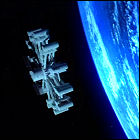 Notes: Produced without any participation from Gene Roddenberry, Strange New World is Warner Bros.’ third and final attempt to launch the PAX saga as a series, since the studio owned the rights to the format Roddenberry developed. To avoid legal entanglements, the character of Dylan Hunt was renamed Anthony Vico, though John Saxon was again cast in the role. The only other common element is the name of the PAX organization (used as a proxy for NASA here), and the basic premise of Hunt/Vico being frozen in suspended animation, only to be revived in a destroyed world which he vows to rebuild to its former glory. This was the last attempt to bring Dylan Hunt to TV in the 1970s; the next attempt, the 2000 premiere of the
Notes: Produced without any participation from Gene Roddenberry, Strange New World is Warner Bros.’ third and final attempt to launch the PAX saga as a series, since the studio owned the rights to the format Roddenberry developed. To avoid legal entanglements, the character of Dylan Hunt was renamed Anthony Vico, though John Saxon was again cast in the role. The only other common element is the name of the PAX organization (used as a proxy for NASA here), and the basic premise of Hunt/Vico being frozen in suspended animation, only to be revived in a destroyed world which he vows to rebuild to its former glory. This was the last attempt to bring Dylan Hunt to TV in the 1970s; the next attempt, the 2000 premiere of the 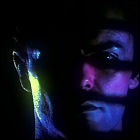 posthumously-produced Gene Roddenberry’s Andromeda, restored Hunt’s name and retained the “man frozen in time awakens to rebuild his world” log line, but shed the PAX concept and the not-so-distant-future-of-Earth setting. The writing talent brought to bear on this final attempt to salvage the Genesis II concept was considerable: Walon Green co-wrote the classic western The Wild Bunch (1969), while Ronald F. Graham (1941-2010) wrote many episodes of UK TV series like The Professionals, The Sweeney, and Dempsey & Makepeace. Al Ramrus wrote episodes of Rat Patrol, The Man From U.N.C.L.E., and The Avengers.
posthumously-produced Gene Roddenberry’s Andromeda, restored Hunt’s name and retained the “man frozen in time awakens to rebuild his world” log line, but shed the PAX concept and the not-so-distant-future-of-Earth setting. The writing talent brought to bear on this final attempt to salvage the Genesis II concept was considerable: Walon Green co-wrote the classic western The Wild Bunch (1969), while Ronald F. Graham (1941-2010) wrote many episodes of UK TV series like The Professionals, The Sweeney, and Dempsey & Makepeace. Al Ramrus wrote episodes of Rat Patrol, The Man From U.N.C.L.E., and The Avengers.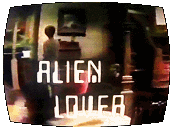
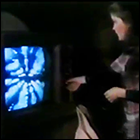 Cast: Pernell Roberts (Mike), Susan Brown (Marian), Kate Mulgrew (Susan), Steven Earl Tanner (Jude), John Ventantonio (Marc), David Lewis (Dr. Steiner), Harry Moses (Richard), and Herman
Cast: Pernell Roberts (Mike), Susan Brown (Marian), Kate Mulgrew (Susan), Steven Earl Tanner (Jude), John Ventantonio (Marc), David Lewis (Dr. Steiner), Harry Moses (Richard), and Herman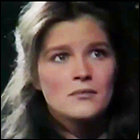 Columbo. She was later a series regular on the late ’80s hospital series Heartbeat, the short-lived early ’90s James Garner series Man Of The People, 2007’s The Black Donnellys, Cartoon Network’s live-action series NTSF:SD:SUV, and most recently was Red in the Netflix series Orange Is The New Black, though anyone reading this site likely knows her best from her seven-year stint as Captain Kathryn Janeway on Star Trek: Voyager, a role she reprised (with a promotion) in 2002’s Star Trek: Nemesis. Alien Lover was a TV movie-of-the-week aired as part of the NBC Mystery Movie, an anthology series that ran from 1973 through 1978, usually leaning on crime/mystery stories, but occasionally dipping into – as was the case here – the paranormal.
Columbo. She was later a series regular on the late ’80s hospital series Heartbeat, the short-lived early ’90s James Garner series Man Of The People, 2007’s The Black Donnellys, Cartoon Network’s live-action series NTSF:SD:SUV, and most recently was Red in the Netflix series Orange Is The New Black, though anyone reading this site likely knows her best from her seven-year stint as Captain Kathryn Janeway on Star Trek: Voyager, a role she reprised (with a promotion) in 2002’s Star Trek: Nemesis. Alien Lover was a TV movie-of-the-week aired as part of the NBC Mystery Movie, an anthology series that ran from 1973 through 1978, usually leaning on crime/mystery stories, but occasionally dipping into – as was the case here – the paranormal.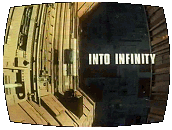 At Space Station Delta, the starship Altares is preparing for an unprecedented mission: the first manned interstellar mission, utilizing a photonic drive that will create a time dilation effect relative to Earth; any messages the Altares crew sends back from Alpha Centauri will reach the descendants of the mission controllers who helped launch the ship. The Altares is crewed by two families, and even the children are fully trained in the technical and scientific aspects of the mission.
At Space Station Delta, the starship Altares is preparing for an unprecedented mission: the first manned interstellar mission, utilizing a photonic drive that will create a time dilation effect relative to Earth; any messages the Altares crew sends back from Alpha Centauri will reach the descendants of the mission controllers who helped launch the ship. The Altares is crewed by two families, and even the children are fully trained in the technical and scientific aspects of the mission.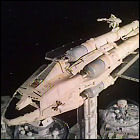 written by Johnny Byrne
written by Johnny Byrne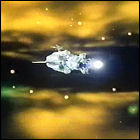 The Keeper Of Traken and the character of Nyssa), Into Infinity was made between the first and second seasons of Space: 1999. As the Altares plunges into the event horizon of the black hole toward the end of the show, a psychedelic sequence ensues which eerily anticipates – in great detail – the bizzaro ending of the 1979 Disney movie The Black Hole. The producers of the later movie were aiming for something cerebral, quasi-spiritual and ambiguous a la 2001: a space odyssey, but the similarities in the hallucinatory sequences near the end of Into Infinity and The Black Hole are striking.
The Keeper Of Traken and the character of Nyssa), Into Infinity was made between the first and second seasons of Space: 1999. As the Altares plunges into the event horizon of the black hole toward the end of the show, a psychedelic sequence ensues which eerily anticipates – in great detail – the bizzaro ending of the 1979 Disney movie The Black Hole. The producers of the later movie were aiming for something cerebral, quasi-spiritual and ambiguous a la 2001: a space odyssey, but the similarities in the hallucinatory sequences near the end of Into Infinity and The Black Hole are striking.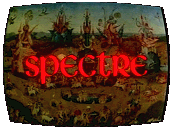
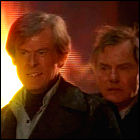 Cast: Robert Culp (Sebastian), Gig Young (Dr. Hamilton), John Hurt (Mitri), James Villiers (Cyon), Majel Barrett (Lilith), Ann Bell (Anitra), Lindy Benson (Third Maid), Sally Farmiloe (Fourth Maid), Angela Grant (Butler), Penny Irving (First Maid), Gordon Jackson (Inspector Cabell), Michael Latimer (Co-Pilot), Vicki Michelle (Second Maid), Jenny Runacre (Sydna)
Cast: Robert Culp (Sebastian), Gig Young (Dr. Hamilton), John Hurt (Mitri), James Villiers (Cyon), Majel Barrett (Lilith), Ann Bell (Anitra), Lindy Benson (Third Maid), Sally Farmiloe (Fourth Maid), Angela Grant (Butler), Penny Irving (First Maid), Gordon Jackson (Inspector Cabell), Michael Latimer (Co-Pilot), Vicki Michelle (Second Maid), Jenny Runacre (Sydna)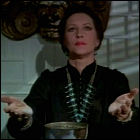 Notes: A familiar leading man at the movies and on TV, Robert Culp (1930-2010) appeared in such genre fare as The Man From U.N.C.L.E., guest shots as three different characters in the 1960s
Notes: A familiar leading man at the movies and on TV, Robert Culp (1930-2010) appeared in such genre fare as The Man From U.N.C.L.E., guest shots as three different characters in the 1960s 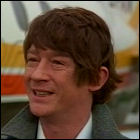 voice of the dragon in the 21st century Merlin series, and appeared as a mysterious iteration of the Doctor during the 50th anniversary year of
voice of the dragon in the 21st century Merlin series, and appeared as a mysterious iteration of the Doctor during the 50th anniversary year of  Revered by his students (and by his art teacher girlfriend), college physics professor Nick Conrad’s strong sense of justice lands him in trouble. He’s present during a mob-organized attempted bank robbery, and when two of the three robbers are shot by bank guards, the third runs – until caught by Nick and handed off to the police. This puts Nick in the mob’s crosshairs, and after one of his student lab assistants is killed by a bomb meant for Nick, he himself is attacked by a hit man who has to leave Nick alive to evade capture. Nick is paralyzed from the waist down, and threats on his girlfriend’s life convince him to stand down as the state’s star witness in the bank robbery prosecution. Dejected and confined to a wheelchair, Nick sullenly returns to his classes and his physics research, which finally bears some fruit – metal than can store enough energy to move itself. Nick sets about building himself an exoskeletal, bulletproof suit that will restore his mobility and protect him…and sets about gathering information on his assailants. Nick’s first test of the Exo-Man suit results in the accidental death of a man he intended to deliver to the police, but not due to Nick’s own actions. It also proves to be a very flawed alpha test, as the suit’s speed, battery capacity and oxygen supply prove to be inadequate. Nick returns to the lab to make the necessary improvements, but does he plan to use the Exo-Man suit to help restore law and order…or to take justice into his own (now very powerfully augmented) hands?
Revered by his students (and by his art teacher girlfriend), college physics professor Nick Conrad’s strong sense of justice lands him in trouble. He’s present during a mob-organized attempted bank robbery, and when two of the three robbers are shot by bank guards, the third runs – until caught by Nick and handed off to the police. This puts Nick in the mob’s crosshairs, and after one of his student lab assistants is killed by a bomb meant for Nick, he himself is attacked by a hit man who has to leave Nick alive to evade capture. Nick is paralyzed from the waist down, and threats on his girlfriend’s life convince him to stand down as the state’s star witness in the bank robbery prosecution. Dejected and confined to a wheelchair, Nick sullenly returns to his classes and his physics research, which finally bears some fruit – metal than can store enough energy to move itself. Nick sets about building himself an exoskeletal, bulletproof suit that will restore his mobility and protect him…and sets about gathering information on his assailants. Nick’s first test of the Exo-Man suit results in the accidental death of a man he intended to deliver to the police, but not due to Nick’s own actions. It also proves to be a very flawed alpha test, as the suit’s speed, battery capacity and oxygen supply prove to be inadequate. Nick returns to the lab to make the necessary improvements, but does he plan to use the Exo-Man suit to help restore law and order…or to take justice into his own (now very powerfully augmented) hands?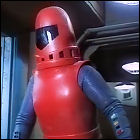 teleplay by Henri Simoun and Lionel E. Siegel
teleplay by Henri Simoun and Lionel E. Siegel It’s just another episode of Anglia TV’s Science Report series, albeit one in which a trail of disappearances of bright, healthy young scientists, engineers, and other thinkers, and a series of unexplained mysteries about the American space program going dormant following the seemingly promising start of the international Apollo-Soyuz mission in 1975, and a videotape handed over to a member of the press for safe keeping by a radio astronomer who died in a mysterious car crash shortly afterward, and troubling reports of climate change lead to an astonishing conclusion: Earth is doomed, and the human race is secretly sending its best and brightest to a colony on Mars to preserve itself.
It’s just another episode of Anglia TV’s Science Report series, albeit one in which a trail of disappearances of bright, healthy young scientists, engineers, and other thinkers, and a series of unexplained mysteries about the American space program going dormant following the seemingly promising start of the international Apollo-Soyuz mission in 1975, and a videotape handed over to a member of the press for safe keeping by a radio astronomer who died in a mysterious car crash shortly afterward, and troubling reports of climate change lead to an astonishing conclusion: Earth is doomed, and the human race is secretly sending its best and brightest to a colony on Mars to preserve itself.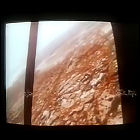 written by David Ambrose
written by David Ambrose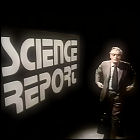 Notes: Originally intended to air on April Fools’ Day (hence the date given at the beginning of the show’s end credits) but delayed by broadcast industry strikes in 1977, Science Report: Alternative 3 was a hoax from beginning to end, devised jointly by its writer (David Ambrose, with credits aplenty on previous Anglia TV series such as Orson Welles’ Great Mysteries) and its director. It’s another entry in that rareified category of “faux newscast” dramas that includes such greats as Special Bulletin,
Notes: Originally intended to air on April Fools’ Day (hence the date given at the beginning of the show’s end credits) but delayed by broadcast industry strikes in 1977, Science Report: Alternative 3 was a hoax from beginning to end, devised jointly by its writer (David Ambrose, with credits aplenty on previous Anglia TV series such as Orson Welles’ Great Mysteries) and its director. It’s another entry in that rareified category of “faux newscast” dramas that includes such greats as Special Bulletin, 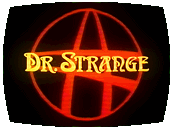
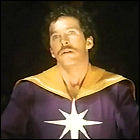 Cast: Peter Hooten (Dr. Strange), Clyde Kusatsu (Mr. Wong), Jessica Walter (Morgan le Fay), Eddie Benton (Clea Lake), Philip Sterling (Dr. Taylor), John Mills (Lindmer), June Barrett (Sarah), Sarah Rush (Nurse), Diana Webster (Head Nurse), Bob Delegall (Intern), Larry Anderson (Magician), Blake Marion (Dept. Chief), Lady Rowlands (Mrs. Sullivan), Inez Pedroza (Announcer), Michael Clark (Taxi Driver), Frank Catalano (Orderly)
Cast: Peter Hooten (Dr. Strange), Clyde Kusatsu (Mr. Wong), Jessica Walter (Morgan le Fay), Eddie Benton (Clea Lake), Philip Sterling (Dr. Taylor), John Mills (Lindmer), June Barrett (Sarah), Sarah Rush (Nurse), Diana Webster (Head Nurse), Bob Delegall (Intern), Larry Anderson (Magician), Blake Marion (Dept. Chief), Lady Rowlands (Mrs. Sullivan), Inez Pedroza (Announcer), Michael Clark (Taxi Driver), Frank Catalano (Orderly)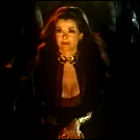 Notes: “Eddie Benton” is a stage name used through 1980 by actress Anne Marie Martin. Ted Cassidy is the uncredited voice of the demon summoned by Morgan to do battle with Dr. Strange. Ironically, though Stan Lee consulted on this movie – obviously intended to be a pilot – more closely than he did any of the other Marvel-derived TV projects of the late 1970s, Dr. Strange went no further than this pilot movie. The character didn’t get a filmed revival until 2016. Paul Chihara’s music for the early portions of this movie make heavy use of the Blaster Beam, an electronic instrument commonly associated with the soundtrack from Star Trek: The Motion Picture. Another television show beat Dr. Strange to the Beam, however: the instrument had featured heavily in the music for an episode of The Bionic Woman aired in January 1978.
Notes: “Eddie Benton” is a stage name used through 1980 by actress Anne Marie Martin. Ted Cassidy is the uncredited voice of the demon summoned by Morgan to do battle with Dr. Strange. Ironically, though Stan Lee consulted on this movie – obviously intended to be a pilot – more closely than he did any of the other Marvel-derived TV projects of the late 1970s, Dr. Strange went no further than this pilot movie. The character didn’t get a filmed revival until 2016. Paul Chihara’s music for the early portions of this movie make heavy use of the Blaster Beam, an electronic instrument commonly associated with the soundtrack from Star Trek: The Motion Picture. Another television show beat Dr. Strange to the Beam, however: the instrument had featured heavily in the music for an episode of The Bionic Woman aired in January 1978.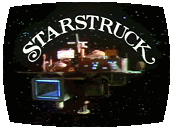
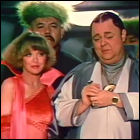 Cast: Beeson Carroll (Ben McCallister), Lynne Lipton (Amber LaRue), Guy Raymond (Ezra McCallister), Meegan King (Mark McCallister), Tania Myren (Kate McCallister), Elvia Allman (Abigail McCallister), Kevin Brando (Rupert McCallister), Robin Strand (Chance), Sarah Kennedy (Delight), Joe Silver (Max), Roy Brocksmith (Orthwaite Frodo), Herb Kaplowitz (Dart), Robert Short (Mr. Hudson), Buddy Douglas (Mrs. Douglas), J.C. Wells (Tashko), Cynthia Latham (Madame Dumont), Forrest J. Ackerman (Alien Astronaut), Jackie O’Brien (Waitress), Billy Scudder (Wolflike Alien)
Cast: Beeson Carroll (Ben McCallister), Lynne Lipton (Amber LaRue), Guy Raymond (Ezra McCallister), Meegan King (Mark McCallister), Tania Myren (Kate McCallister), Elvia Allman (Abigail McCallister), Kevin Brando (Rupert McCallister), Robin Strand (Chance), Sarah Kennedy (Delight), Joe Silver (Max), Roy Brocksmith (Orthwaite Frodo), Herb Kaplowitz (Dart), Robert Short (Mr. Hudson), Buddy Douglas (Mrs. Douglas), J.C. Wells (Tashko), Cynthia Latham (Madame Dumont), Forrest J. Ackerman (Alien Astronaut), Jackie O’Brien (Waitress), Billy Scudder (Wolflike Alien)
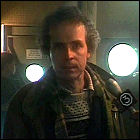 Cast: Ed Flanders (John Woodley), Kathryn Walker (Susan Myles), Roxanne Hart (Meg Barclay), Christopher Allport (Steven Levitt), David Clennon (Dr. Bruce Lyman), David Rasche (Dr. David McKeeson), Rosalind Cash (Frieda Barton), Ebbe Roe Smith (Jim Seaver), Roberta Maxwell (Diane Silverman), Robert Kay (George Takashima), J. Wesley Huston (Bernard Frost), Frank Dent (Dr. Jason Halpern), Charles Lanyer (Merritt Cunningham), Mie Hunt (Ellen Stevens), Bruce Fields (Walter Letteau), Lane Smith (Morton Sanders), Jim Jansen (Arlen Surrey), Peter Hobbs (Jonathan E. Herman), Mary Armstrong (Interviewee), Bernard Behrens (Dr. Neils Johanssen), Ivan Bonar (Interviewee), Ron Frazier (Interviewee), Bruce Frank (Interviewee), Elizabeth Gill (Interviewee), June Kim (Hiroshima Interviewee), George Morfogen (Interviewee), Duncan Ross (Interviewee), Bill Saito (Hiroshima Interviewee), Kenneth Tigar (Dr. Abraham Sczrsma), John Walsh (Interviewee), Steve Arvin Interviewee(), Edwin Bernstein (Interviewee), Wanda Bowe (Interviewee), Robert Buckingham (Interviewee), Judie Carroll (Interviewee), Marian A. Carter (Interviewee), Kelly Condon (Interviewee), William A. Gimble Jr.
Cast: Ed Flanders (John Woodley), Kathryn Walker (Susan Myles), Roxanne Hart (Meg Barclay), Christopher Allport (Steven Levitt), David Clennon (Dr. Bruce Lyman), David Rasche (Dr. David McKeeson), Rosalind Cash (Frieda Barton), Ebbe Roe Smith (Jim Seaver), Roberta Maxwell (Diane Silverman), Robert Kay (George Takashima), J. Wesley Huston (Bernard Frost), Frank Dent (Dr. Jason Halpern), Charles Lanyer (Merritt Cunningham), Mie Hunt (Ellen Stevens), Bruce Fields (Walter Letteau), Lane Smith (Morton Sanders), Jim Jansen (Arlen Surrey), Peter Hobbs (Jonathan E. Herman), Mary Armstrong (Interviewee), Bernard Behrens (Dr. Neils Johanssen), Ivan Bonar (Interviewee), Ron Frazier (Interviewee), Bruce Frank (Interviewee), Elizabeth Gill (Interviewee), June Kim (Hiroshima Interviewee), George Morfogen (Interviewee), Duncan Ross (Interviewee), Bill Saito (Hiroshima Interviewee), Kenneth Tigar (Dr. Abraham Sczrsma), John Walsh (Interviewee), Steve Arvin Interviewee(), Edwin Bernstein (Interviewee), Wanda Bowe (Interviewee), Robert Buckingham (Interviewee), Judie Carroll (Interviewee), Marian A. Carter (Interviewee), Kelly Condon (Interviewee), William A. Gimble Jr. 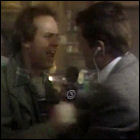 (Interviewee), William J. Ghinta (Interviewee), Liberty Godshall (Interviewee), Ray Godshall (Interviewee), Virginia Gourdin (Interviewee), Steven Ledford (Interviewee), Marc Levy (Interviewee), Michael Madsen (Jimmy Lenox), Robert Marks (Interviewee), Joe Mays (Interviewee), Arthur McDonald Interviewee(), David Moses (Interviewee), Arthur R. Nuzzo (Interviewee), Ellen Ren (Interviewee), Adrian Ricard (Interviewee), Steven M. Sawyer (Interviewee), Sadina H. Terry (Interviewee), Jack Thompson (Tennessee Senator), Celestine Turner (Interviewee), David VandeBrake (Interviewee), Elizabeth Young (Interviewee), Sam Youngblood (Interviewee), Randolph Hille (Politician), John Wesley (Bernard Frost)
(Interviewee), William J. Ghinta (Interviewee), Liberty Godshall (Interviewee), Ray Godshall (Interviewee), Virginia Gourdin (Interviewee), Steven Ledford (Interviewee), Marc Levy (Interviewee), Michael Madsen (Jimmy Lenox), Robert Marks (Interviewee), Joe Mays (Interviewee), Arthur McDonald Interviewee(), David Moses (Interviewee), Arthur R. Nuzzo (Interviewee), Ellen Ren (Interviewee), Adrian Ricard (Interviewee), Steven M. Sawyer (Interviewee), Sadina H. Terry (Interviewee), Jack Thompson (Tennessee Senator), Celestine Turner (Interviewee), David VandeBrake (Interviewee), Elizabeth Young (Interviewee), Sam Youngblood (Interviewee), Randolph Hille (Politician), John Wesley (Bernard Frost)